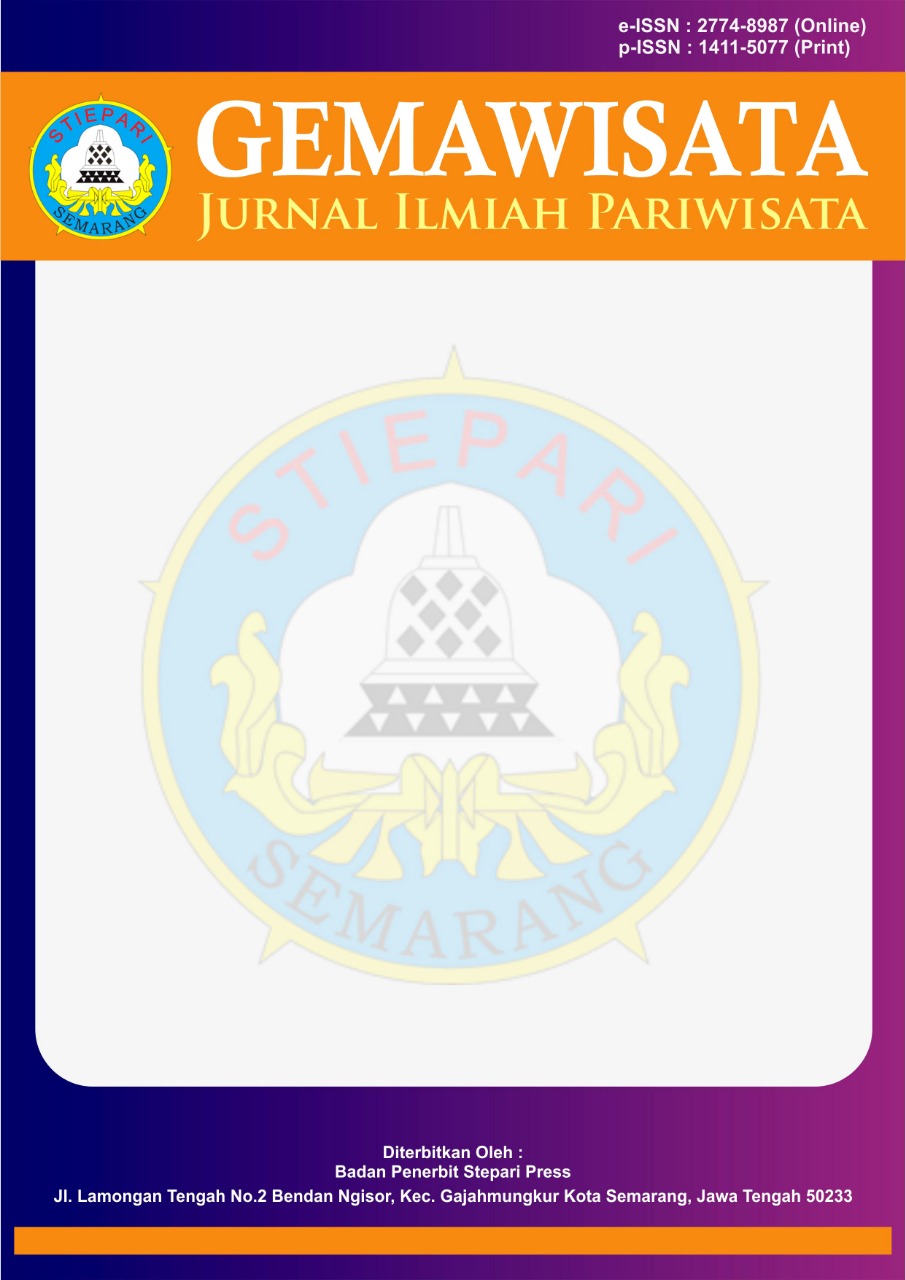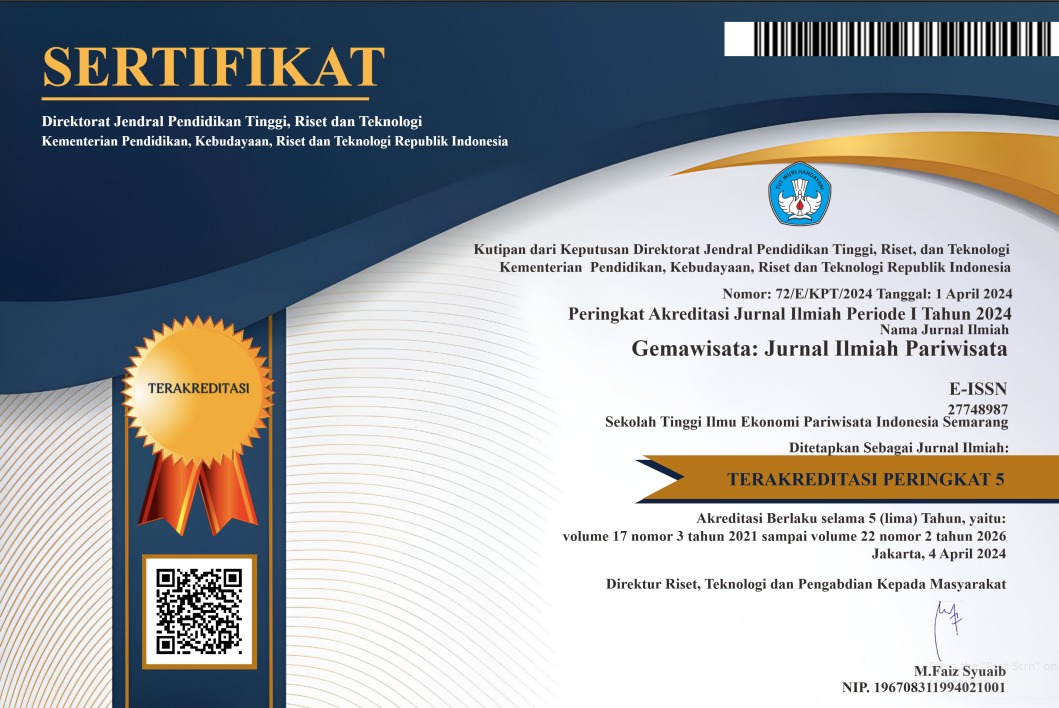Pengaruh Kualitas Layanan dan Atraksi Wisata terhadap Kepuasan Wisatawan di Batu Parsidangan Siallagan Samosir
DOI:
https://doi.org/10.56910/gemawisata.v21i3.846Keywords:
Batu Parsidangan, Cultural Tourism, Service Quality, Tourist Attraction, Tourist SatisfactionAbstract
This research was conducted based on the observation that Batu Parsidangan Siallagan is one of the main tourist destinations in Samosir Regency and consistently attracts many visitors. The site is highly rated on several travel platforms, confirming its strong potential as a cultural tourism icon. However, despite this popularity, some visitors provide negative feedback, particularly regarding inconsistent service quality, attractions that do not fully meet expectations, and inadequate supporting facilities. These conditions encourage further study to analyze tourists’ perceptions of service quality and tourist attractions, as well as their influence on visitor satisfaction. A total of 99 respondents were selected using purposive non-probability sampling to ensure the data collected aligned with the research objectives. Data were gathered using a structured questionnaire tested for validity and reliability, then analyzed through descriptive statistics and inferential methods, including multiple regression, the coefficient of determination, t-test, and F-test. The findings show that service quality and attractions together account for 56.3% of the variation in visitor satisfaction. These results highlight the need to enhance service quality, create more engaging cultural attractions, improve supporting facilities, and provide continuous training for local human resources so that Batu Parsidangan Siallagan can maintain its status as a leading tourist destination.
References
Al Dakheel, J., Del Pero, C., Aste, N., & Leonforte, F. (2020). Smart buildings features and key performance indicators: A review. Sustainable Cities and Society, 61, 1–9. https://doi.org/10.1016/j.scs.2020.102328
Andrianto, H., Susanthi, Y., & Jonathan, V. (2024). Platform sistem pemantauan penggunaan energi listrik berbasis IoT. Techné Jurnal Ilmiah Elektroteknika, 23(2), 199–212. https://doi.org/10.31358/techne.v23i2.422
Hakim. (2010). Evaluasi sistem bangunan pintar pada pusat perbelanjaan Senayan City di Jakarta. Arsitron, 1(2), 84.
Hendrawan, A. P. W., & Agustini, N. P. (2022). Simulasi kendali dan monitoring daya listrik peralatan rumah tangga berbasis ESP32. Alinier Jurnal, 3(1), 55–68. https://doi.org/10.36040/alinier.v3i1.4855
Inggi, R., & Pangala, J. (2021). Perancangan alat pendeteksi kebocoran gas LPG menggunakan sensor MQ-2 berbasis Arduino. SIMKOM, 6(1), 12–22. https://doi.org/10.51717/simkom.v6i1.51
Islam, H. I., Nabilah, N., Atsaurry, S. S., Saputra, D. H., Pradipta, G. M., Kurniawan, A., Syafutra, H., Irmansyah, I., & Irzaman, I. (2016). Sistem kendali suhu dan pemantauan kelembaban udara ruangan berbasis Arduino Uno dengan menggunakan sensor DHT22 dan passive infrared (PIR). Prosiding Seminar Nasional Fisika (E-Journal) SNF2016, SNF2016-CIP-119–SNF2016-CIP-124. https://doi.org/10.21009/0305020123
Juliansyah, A., & Nadiani, D. (2021). Sistem pendeteksi gerak menggunakan sensor PIR dan Raspberry Pi (Motion detection system using PIR sensors and Raspberry Pi). JTIM: Jurnal Teknologi Informasi dan Multimedia, 2(4), 199–205. https://doi.org/10.35746/jtim.v2i4.113
Najib, W., Sulistyo, S., & Kunci, K. (2020). Tinjauan ancaman dan solusi keamanan pada teknologi Internet of Things (Review on security threat and solution of Internet of Things technology). Jurnal Nasional Teknik Elektro dan Teknologi Informasi, 9(4), 375–384. https://doi.org/10.22146/jnteti.v9i4.539
Pratama, E. W., & Kiswantono, A. (2023). Electrical analysis using ESP-32 module in realtime. JEECS (Journal of Electrical Engineering and Computer Sciences), 7(2), 1273–1284. https://doi.org/10.54732/jeecs.v7i2.21
Puriyanto, R. D., & Rosyady, P. A. (2021). Pengukuran besaran listrik (B. Ashari, Ed.). UAD Press.
Rachmadi, T. (2020). Mengenal apa itu Internet of Things: Cara menghadapi industry 4.0 dimana kita diharuskan serba digital terus mempelajari teknologi baru atau anda akan tertinggal oleh zaman (1st ed.). Tiga Ebook.
Royhan, M. (2020). Pemasangan lampu penerangan di ruang dengan sensor passive infrared receiver (PIR) terintegrasi Arduino. Journal of Informatics and Communications Technology (JICT), 2(2), 8–16. https://doi.org/10.52661/j_ict.v2i2.54
Susanto, A. T., & Purwoko, H. (2023). Perancangan proyek kantor Mitra Surya dengan pendalaman smart building system. Kreasi, 8(2), 16–29. https://doi.org/10.37715/kreasi.v8i2.4490
Zalfin, A. (2021). Studi pengaruh lekukan kabel terhadap arus listrik. Politeknik Negeri Ujung Pandang.
Zulkifli, Z., Muhallim, M., & Hasnahwati, H. (2024). Pengembangan sistem alarm dan pemadam kebakaran otomatis menggunakan Internet of Things. Jurnal Informatika dan Teknik Elektro Terapan, 12(3), 2444–2460. https://doi.org/10.23960/jitet.v12i3.4774


1_(1).jpg)






